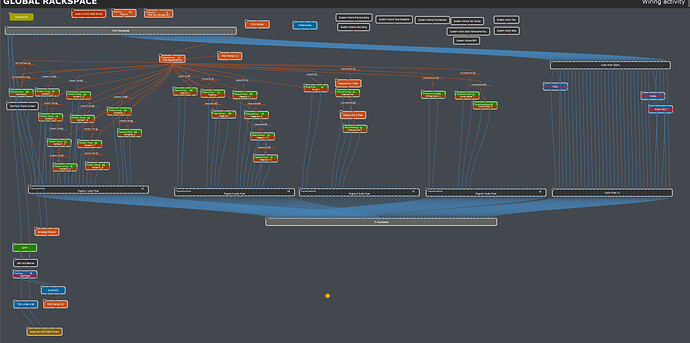Here is a new blog article → Why a graphic interface is superior to the channel strip model
And to not forget, Alistair’s plugin chains! ![]() → see here.
→ see here.
Holy Moly!
My ‘proof’ that this is not possible in a channel strip model.
Let alone the 1,500 lines of scripting belonging to the wiring diagram.
Apparently Logitech agrees that graphic interfaces are superior. Interesting software they just released, looks like some kind of basic mixing software aimed at the general public.
It’s for streaming from multiple sources.
Got it. Either way looks like we might start seeing this kind of interface in more software because it just makes sense.
No, this concept is not new for general routing of audio. Numerous apps have been doing this for years, some for decades, for audio, graphics and video processing.
Native Instruments Reaktor works this way as does MaxMSP.
The general paradigm is known as dataflow and for those interested in history, the paradigm was first suggested back in 1961, over 60 years ago.
And this is also the way the most advanced AI-based imaging software works (ComfyAI).
–
And a comment:
Totally with you on this one. Signal flow is the works and with Gig Performer you can invent ANY signal flow you can imagine and at a glance, you can see exactly what’s going on. With channel strips you have to follow one signal to the next and verify each step, just in case you’re sending something where you don’t want to… And when you get into multiple layers of sends, channel strips become an odyssey… Whereas in Gig Performer you see everything at a glance.
A comment from Craig Fitzgerald on the Gig Performer YouTube channel (here) :
Gig Performer is so much easier to work within setting up MIDI on multiple VST instruments than my DAW; with multiple MIDI inputs.
Then use GP Relayer into the DAW to record. Using Tripleplay on one of my guitars to a left and right synth, use the Transpose plugin to drop the right hand down an octave through an arpeggiator, through GP Relayer then through my outputs.
Spent an hour trying to do it in my DAW, couldn’t get it right, took 5 minutes to get it setup in Gig Performer.





